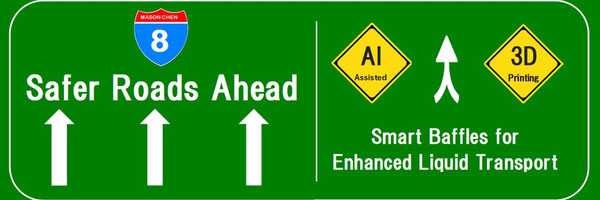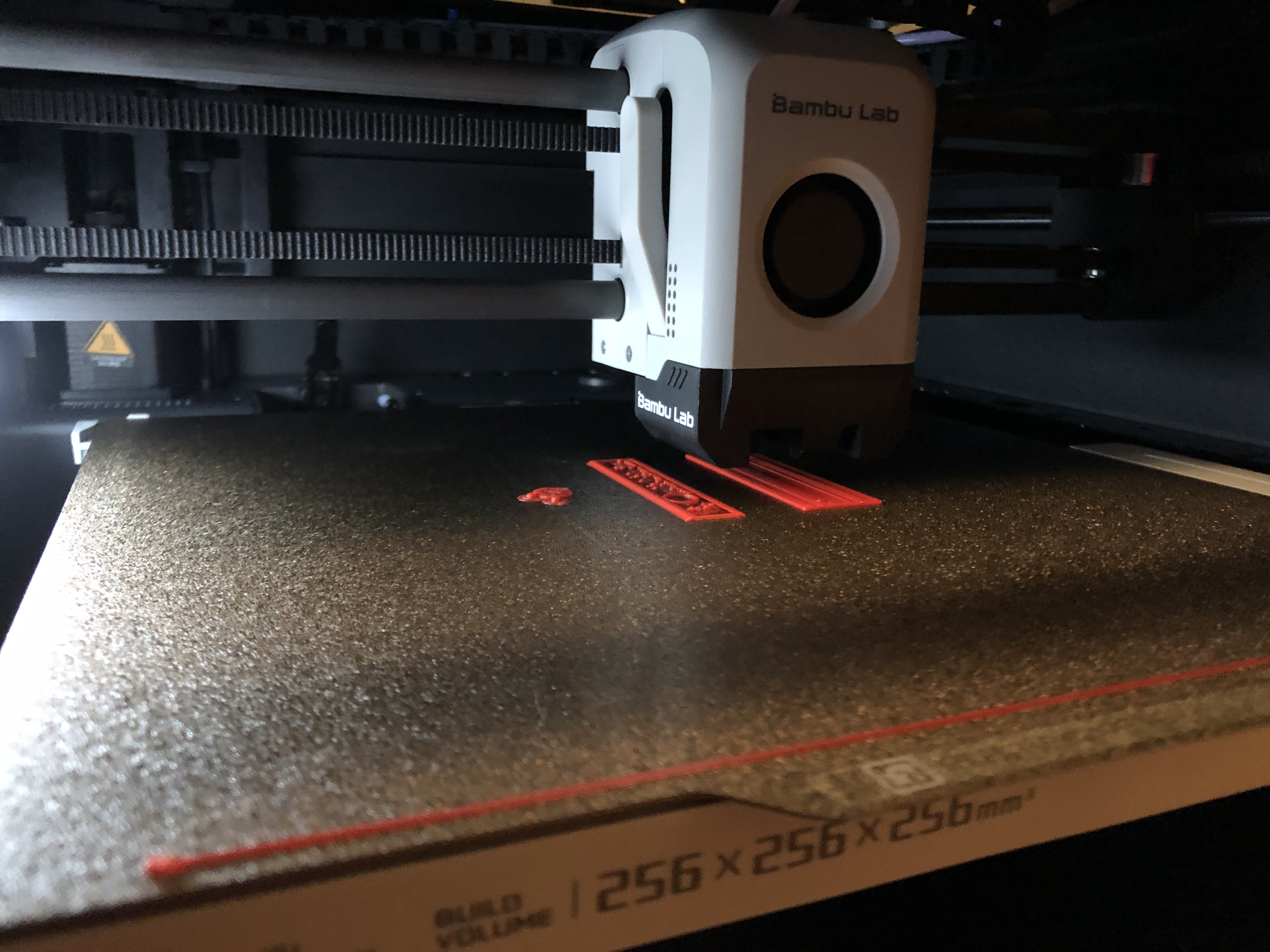Safer Roads Ahead: AI-Assisted 3D Printing of Smart Baffles for Enhanced Liquid Transport
Grade 8
Presentation
Problem
Abstract
Tanker trucks are critical in transporting liquids. However, they are very prone to rollover accidents, with more than 63% involving partially loaded tanks. There are over 1,300 tanker rollover incidents in the U.S. every year [1]. In Canada, 83% of highway vehicle rollovers are contributed by tanker trucks [2].
These incidents are often caused by destabilising effects, such as liquid sloshing, sudden abrupt manoeuvres, etc. In addition to the immediate safety risk of the driver and other road users, tank rollover incidents often lead to fuel spills. They can result in severe pollution of the environment, contamination of water supplies, and very costly cleanup efforts. According to the US Federal Motor Carrier Safety Administration (FMCSA), flammable liquids, such as gasoline, fuel oil, etc., led to 42% of the Hazardous Materials (HM) releases from cargo compartments in fatal crashes and 49% of the HM releases in injury and towaway crashes [3].

Large trucks in crashes by Hazardous Materials (HM) cargo type, HM release, and crash severity
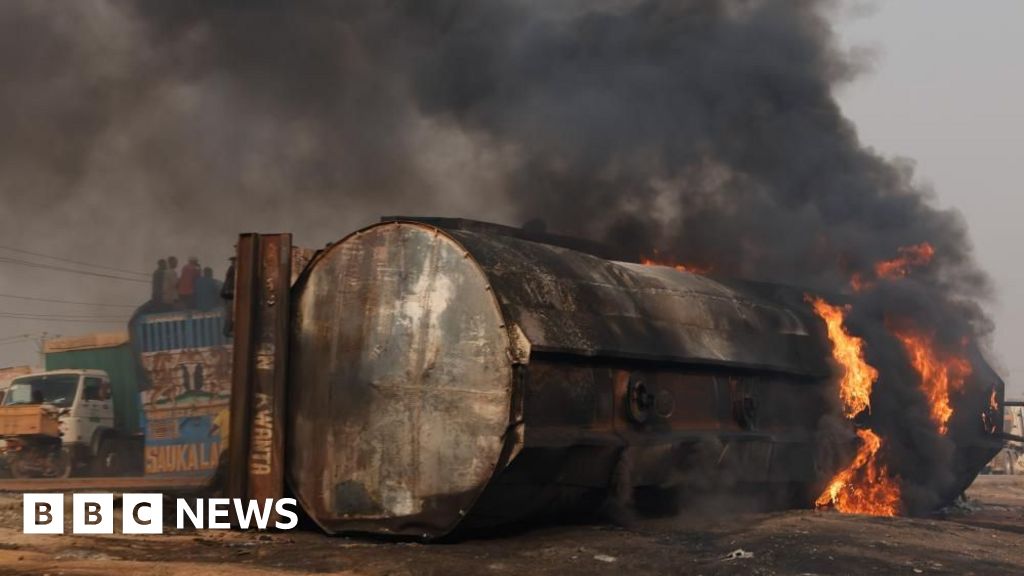
Every year, hundreds of incidents occur with oil tanker trucks, taking many lives of those drivers, and other road users. Besides for the lives lost , it can also causes major fuel spills, and contamination of water supplies.
Current Solutions Against this Problem
Currently, there are some solutions against this problem, for example the use of baffles, and bulkheads (Internal compartments or perforated barriers reduce liquid movement and minimize sloshing) within a tanker. Trucks are also equipped with special breaks and stability system to improve the overall balance of the truck. However, these prove to not be effective enough to cope with the challenges sloshing has provided.

The inside of a fuel tanker with standard baffles
Objectives
The long-term effect of the spills brings out the urgency of preventing these accidents. Baffles have been used oil tankers to mitigate the risks. However, traditional baffle designs are not effective enough to cope with the challenges effectively, leaving room for innovation of new smart baffles.
This project is inspired by the critical need for improved tank safety while decreasing environmental risks. This project aims to enhance tanker safety while minimizing environmental pollution risks, by adopting 3D modelling and printing, and AI-assisted analysis. The main goal is to find out the optimized baffle designs that reduce sloshing, enhance stability, and decrease the risk of fuel spills. To make the results as realistic to real-life tanker operations, it simulates real-world scenarios, repeats testing and keeps improving the designs. This is important for enhancing safety and protecting the environment.
Final Project Question
How can I design and contruct a low-cost, effective baffle design that can reduce sloshing, and ultimately reduce rollover risks in oil tanker trucks?
Method
Why simulate and test with RC tractor and 3D-Printed models?
I created scaled-down models to investigate and test the sloshing and rollover risks. I modified an RC car into a tractor, and 3D-printed a trailer with swappable tanks. This configuration made controlled and repeatable experiments possible, so that I could mimic real-life scenarios. This approach is cost-effective, flexible in design, repeatable, safe, and easy to control.
In this project, 3D modelling was crucial for me to replicate the tank and other parts accurately. The process included many iterations of tank designs. I started with small prototypes designed in TinkerCAD. Later into this project, the limitation in features of TinkerCAD turned to a bottleneck. After some investigation, I decided to adopt and learn Autodesk Fusion 360, a professional CAD 3D modelling software (Thanks to Autodesk for providing access to professional software free to students). It helped me to create the final version of my tanks. After modelling, I proceeded to 3D print these tanks on my Bambu Lab P1S 3D printer.
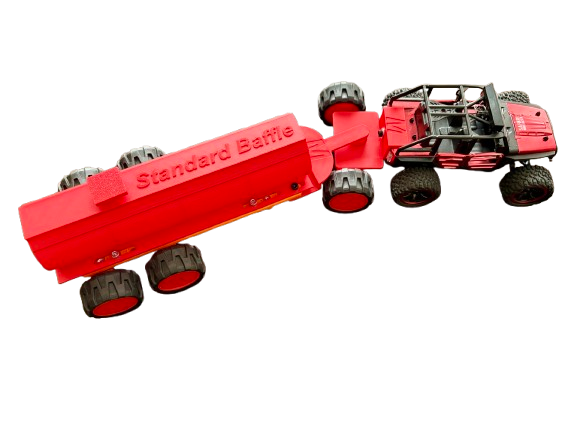
Tractor and Trailer with Tanker
Bambu Lab P1S printing an early prototype of oil tanker truck
Why use AI (ChatGPT) to help analysis?
- Saving time and costs: I had many different ideas of baffle design, but it would be very time-consuming and expensive to test all of them. ChatGPT helped me to analyze the designs and sort out the most promising models. Using ChatGPT, I saved time and cost in modelling, printing, and testing my ideas.
- Learning knowledge: I lacked some knowledge of physics and math that was required to calculate sloshing frequency, energy dissipation, and rollover risks as a student in grade 8. ChatGPT helped to simplify the concepts and analyze the performance of the designs while showing me fluid dynamics and engineering knowledge.
Procedure
-
Conduct the modelling and testing
- I have followed the below steps to determine the performance data of different baffle designs for the sloshing and rollover risks:
- Model creation: 3D modelling the tankers with same size, shape, and internal structure, and printing them.
- RC tractor and trailer setup: Modifying an RC car into a tractor to allow it to tow a trailer that holds interchangeable tank securely during testing.
- Scenarios testing: testing the setup of RC tractor and trailer to control the conditions to simulate real-world tanker problems, for example straight-line acceleration and braking, as well as sharp turns.
- Data collection: Using a device to record all the tests in both normal speed and slow-motion, observing the sloshing level, and measuring the distance of braking and stopping after sharp turn.
- Result analysis: Analyzing the data to rank the baffle design based on the performance from the perspectives of sloshing and rollover risks.
-
Variables
- Fixed/Controlled variable(s):
- RC car
- Tank size
- 3D printing settings
- Amount of liquid (water)
- Testing scenario
- Manipulated/Independent variable(s):
- Baffle design
- Responding/Dependent variable(s):
- Rollover rate
- Sloshing frequency
- Amplitude reduction
- Stability impact
- Fixed/Controlled variable(s):
-
Hypothesis
- Based on the procedure and variables defined above, the hypothesis of this project is formulated as:
- IF: the baffle design is improved,
- THEN: the safety of liquid transport will be enhanced in terms of rollover rate, sloshing frequency, amplitude reduction, and stability impact,
- BECAUSE: turbulence is better controlled, the surface contact within the liquid is increased, and/or energy is better dissipated.
Baffle Designs and Comparison
To create the trailer and tanker model, I used an RC car as the baseline and followed a similar ratio to design the trailer and tanks. After researching industry-standard designs from the OKT Trailer [4] and Stream Logistics [5] websites, I finalized the tank design as an oval shape, which is the most popular design for road tankers. Also, I selected a step deck design, which is widely used as well.
As mentioned in the previous sections, the tanker dimensions stay the same, and five baffle designs were made.
Tanker
- Baffle 1 - standard baffle (baseline)
Standard Baffle
-
- Effect: Regular baffles disrupt liquid movement by decreasing flow and the free surface area for wave formation.
- Calculation Impact: The baffles will increase energy loss (damping), reducing the peak sloshing motion and stabilizing the liquid quicker.
- Baffle 2 - baffle balls
-
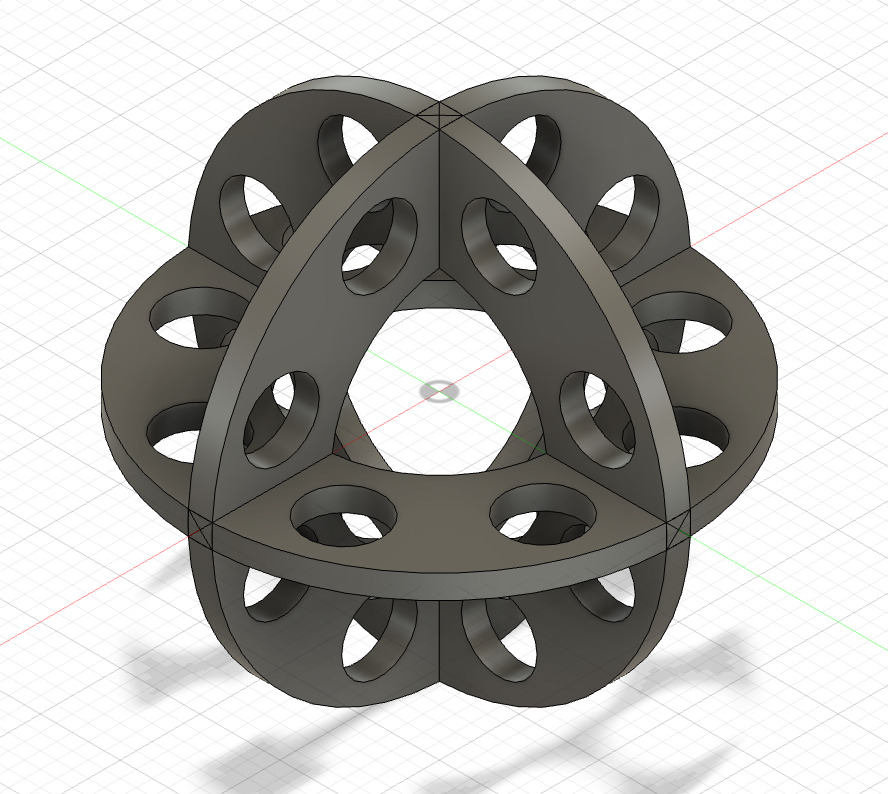
Baffle Ball
-
- Effect: The baffle balls, containing blades and hollow space, would allow for partial liquid movement through the ball but dissipate energy due to drag and internal flow resistance.
- Calculation Impact: These would reduce the strength of sloshing waves but do not alter the frequency as much as fixed baffles. The drag coefficient caused by the balls would influence the dissipation.
- Baffle 3a - freely rotatable propeller baffle
Freely Rotatable Propeller Baffle
-
- Effect: Freely rotatable propellers allow for dynamic movement with the liquid's motion. As waves push the blades, the propellers spin, converting wave energy into rotational motion. This increases energy dissipation and reduces sloshing by adding additional drag and turbulence.
- Calculation Impact: This design would reduce both sloshing amplitude and frequency the most due to the high resistance and turbulent flow generated.
- Baffle 3b - stacking static propeller (same direction) baffle

Stacking Static Propeller (Same-Direction) Baffle
- Effect: Fixed propellers with the same spiral direction create a controlled swirling motion throughout the liquid. The spiral flow helps dissipate wave energy by creating turbulence and reducing the liquid's free surface motion.
- Calculation Impact: This design effectively reduces sloshing amplitude by disrupting wave patterns.
- Baffle 3c - stacking static propeller (opposite-direction) baffle

Stacking Static Propeller (Opposite-Direction) Baffle
-
- Effect: Fixed propellers with opposite spiral directions would create a swirling motion. This forces the liquid into controlled circular paths, thus significantly increasing energy dissipation.
- Calculation Impact: This design would reduce both sloshing amplitude and frequency the most due to the high resistance and turbulent flow generated.
Baffle design comparison and decision
- The above five designs of baffle were compared in terms of
- Sloshing frequency: Sloshing rate of liquid waves in tank.
- Amplitude reduction: Reduction of waves height caused by baffles.
- Stability impact: Effectiveness of a baffle system in maintaining vehicle balance and reducing rollover risks.
I reviewed all the designs with ChatGPT, which provided the comparison results shown in the table below. Since Baffles 3a, 3b, and 3c have similar designs, with 3c standing out as the best performer, I decided to select Baffle 3c. Additionally, I chose Baffle 2 as a contrasting design to explore different approaches. To evaluate their effectiveness, I proceeded with modelling, printing, and testing of Baffle 3c, Baffle 2, and the baseline model for comparison.
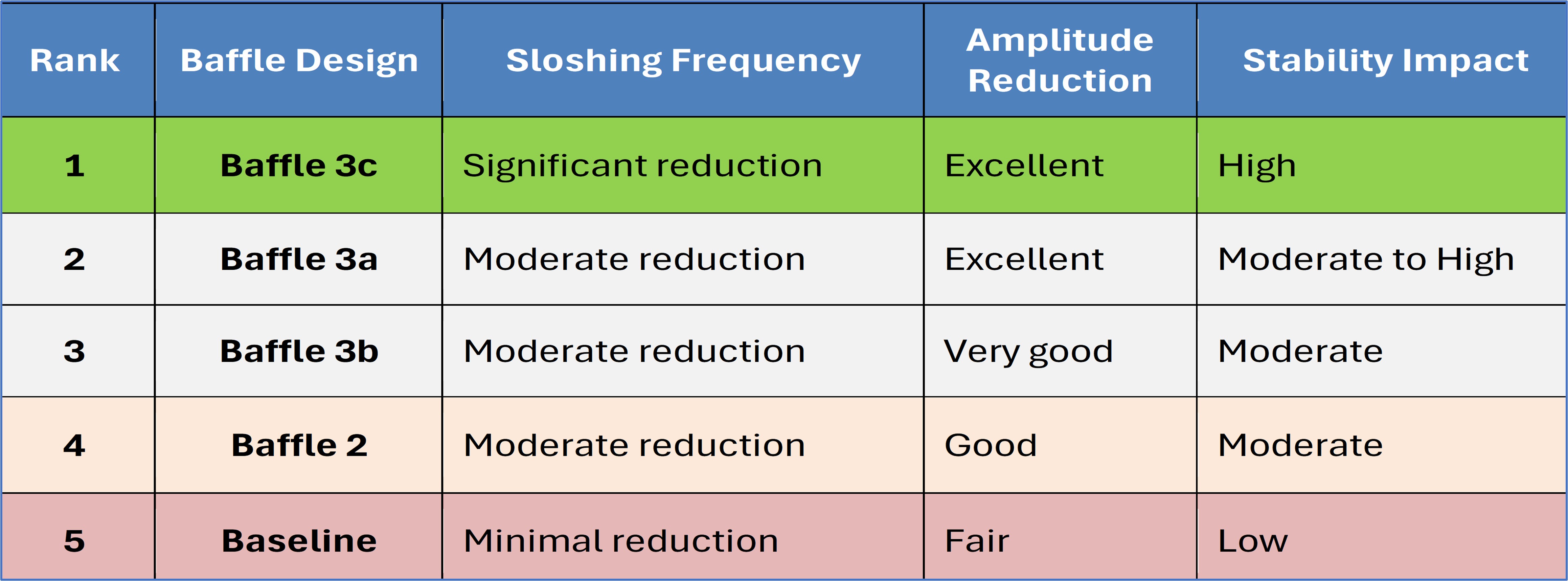
Baffle Design Comparison Summary
Testing and Verification
Testing Scenarios: The RC tractor and trailer were tested repeatedly (10 times for each solution with each challenge) under controlled conditions
- Liquid amount: 210ml water
- Acceleration distance: 270cm
to simulate real-world tanker challenges
- Straight-Line acceleration and deceleration: To observe sloshing during sudden stops and starts and measure the braking distance.
- Sharp turns: To measure the tank’s resistance to rollover due to liquid inertia and measure the stopping distance after turns.

Testing Results
According to the testing results, compared to the baseline (standard baffle), the average braking distance of baffle ball and stacking static propeller (opposite-direction) baffle respectively reduced by 19% and 29%, and the stopping distance after turns reduced by 2% and 13%.
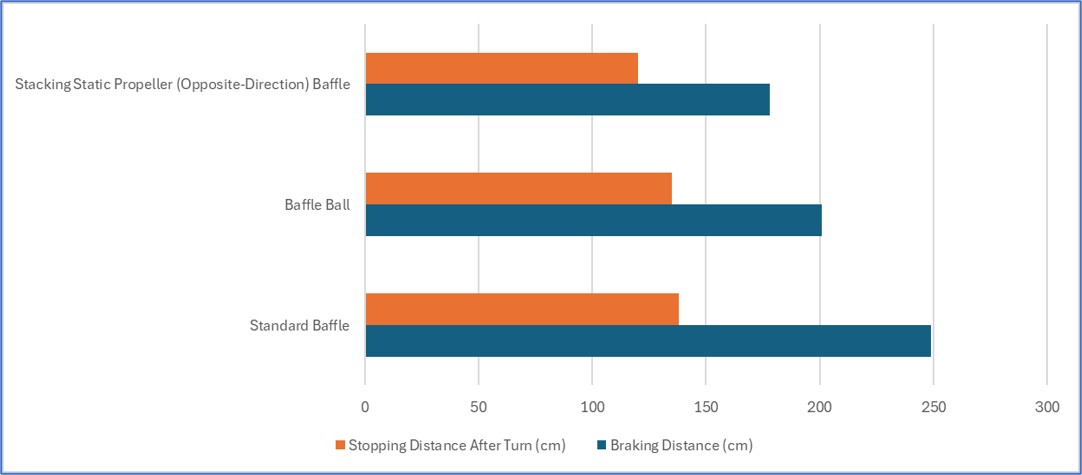
Braking and Stopping Distance
The below images show the sloshing level of each solution captured by slow-motion recordings. The water level difference between point A and B represents the sloshing level:
Sloshing Level of Standard Baffle
Sloshing Level of Baffle Ball
Sloshing Level of Stacking Static Propeller (Opposite-Direction) Baffle
The Standard Baffle (Baseline) couldn't control the sloshing, leaving large waves in the tanker. In contrast, the Baffle Ball tanker had much smaller waves. Lastly, the Stacking Static Propeller (Opposite-Direction) Baffle significantly reduced sloshing, with waves barely visible.
Analysis
The Best Solution:
Baffle 3c - stacking static propeller (opposite-direction) baffle
By forcing controlled turbulence and disrupting wave formation, the propeller baffles provide the most sloshing reduction, both in amplitude and frequency.
-
- Controlled motion: The propeller-shaped baffles are fixed and designed with opposite spiral directions. This forces the liquid to move in a controlled and circular motion instead of creating large and random waves, which result in reduction of the formation of free-surface sloshing waves and faster energy dissipation due to increased turbulence and resistance.
-
- Increased surface contact: The spiral blades interact with the liquid at multiple points and directions. This results in the disruption of the energy transfer of the sloshing waves.
- Higher energy dissipation: The liquid is constantly redirected, so that it creates turbulent flow and energy loss. This dissipates the sloshing energy quickly and stabilizes the liquid effectively.
A Fair Solution:
Baffle 2 - baffle balls
The baffle balls reduce waves more effectively than the standard baffles because they add dynamic resistance to liquid movement. This leads to slower waves without abrupt restriction of flow.
-
- Energy dissipation: Because the baffle balls are designed to be hollow with blades, they allow partial liquid flow and create drag forces when the liquid passes through them. The blades resist the flow, so the wave motion is slowed down, and sloshing amplitude is reduced.
- Random flow interference: The balls can move freely within in tank. Therefore, they interact with the liquid waves in multiple and random directions. As a result, the wave movement becomes less, and energy dissipates over time.
The Least Effective Solution:
Baffle 1 - standard baffle
Regular baffles disrupt some sloshing but are less efficient because they don’t add independent flow resistance and turbulence like the other designs.
-
- Static wave interruption: Regular baffles are flat plates that block liquid movement in certain areas. While they partially reduce wave movement, they don’t significantly redirect flow or dissipate energy.
- Free surface waves: The liquid has large free-surface areas for waves to form around the baffles, leading to less reduction in sloshing.
- Limited energy loss: Regular baffles primarily block flow but don’t create enough turbulence or drag to dissipate energy efficiently.
Conclusion
Concluding Statement
In conclusion, the Stacking Opposite-Direction Static Propeller Baffle exceeds the others because it uses turbulence, redirection, and controlled spiral motion to minimize sloshing, whereas the Baffle Balls rely on drag and the Regular Baffles are only able to partially block waves.
- Stacking Opposite-Direction Static Propeller Baffle: Controlled Motion, Increased Surface Contact, Higher Energy Dissipation
- Baffle Ball: Fair Energy Dissipation, Random Flow Interference
- Standard Baffle: Static Wave Interruption, Free Surface Waves, Limited Energy Loss
Practical Applications
The Smart Baffle Design significantly improves fuel tanker safety by reducing sloshing, rollover risks, and braking distances. Traditional tankers are not effective enough with liquid instability, especially during sharp turns, sudden stops with partial loads. It causes longer braking distances and increases accident risks. This stacking opposite-direction propeller baffle design has been proven to reduce fuel movement, minimize sloshing forces, and improve tanker truck stability.
Additionally, the Smart Baffle improves fuel handling safety by smoothing liquid transport, preventing surges and spills. It also helps prevent pollution by reducing the chance of fuel leaks caused by excessive movement. This innovation makes fuel transport safer, more cost-effective, and environmentally responsible, paving the way for a more secure and sustainable fuel logistics industry in the future.
Sources of Error/Improvments for the Future
During our testing/experiments, I was only able ot test all of the scenarios on a flat surface, however, in real life, there are also hills. and uneven surfaces. To solve this issue in the future, I would bring the tractor and trailer set up to a skatepark to test the "real life" scenarios.
If I were to continue this project, I would also conduct some Computational Fluid Dynamics (CFD) simulations to further validate my results and findings. This would help ensure greater accuracy by analyzing fluid behavior in more detail and comparing it with my existing data.
Citations
References/Citations
[1] Large Truck & Tanker Rollover Prevention: https://www.aig.com/content/dam/aig/america-canada/us/documents/business/risk-engineering/driver-vehicle-safety/lcb-large-truck-and-tanker-rollover-prevention.pdf.coredownload.pdf
[2] J.R. Billing and J.D. Patten National Research Council of Canada, An Assessment of Tank Truck Roll Stability: https://hvttforum.org/wp-content/uploads/2019/11/An-Assessment-of-Tank-Truck-Roll-Stability-Billing.pdf
[3] Federal Motor Carrier Safety Administration (FMCSA) Summary Report: https://ai.fmcsa.dot.gov/CrashStatistics?tab=Summary&type=&report_id=1&crash_type_id=4&datasource_id=1&time_period_id=2&report_date=0&vehicle_type=1&state=NAT&domicile=ALL&measure_id=1&operation_id=null
[4] Elliptical Tanker Semi Trailer: https://www.okt-trailer.com/eliptic-tanker-semi-trailer
[5] Trailer Types & Dimensions: https://streamlogistics.com/trailer-dimensions/
[6] An Analysis of Fuel Oil Sloshing in Partially Filled Cargo Tanker Trucks under Cornering Conditions Using Various Baffle Systems: https://onlinelibrary.wiley.com/doi/10.1155/2023/9941864
Acknowledgement
Acknowledgement
I would like to express my heartfelt gratitude to everyone who was involved and supported me throughout this science fair project. I would thank Autodesk for providing access to professional software free to students. I would like to thank my science teacher and coordinators for organizing such a great event. I am also extremely grateful to my parents, who provided me tons of support, inspirations, and most of all motivation to keep things rolling. Thank you to everyone who has contributed to this project and making this experience both educational and memorable!

